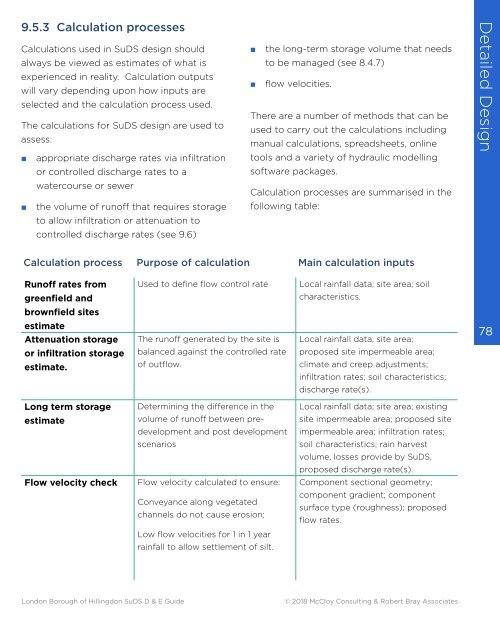Hillingdon SuDS Design & Evaluation Guide
Create successful ePaper yourself
Turn your PDF publications into a flip-book with our unique Google optimized e-Paper software.
9.5.3 Calculation processes<br />
Calculations used in <strong>SuDS</strong> design should<br />
always be viewed as estimates of what is<br />
experienced in reality. Calculation outputs<br />
will vary depending upon how inputs are<br />
selected and the calculation process used.<br />
The calculations for <strong>SuDS</strong> design are used to<br />
assess:<br />
■■<br />
■■<br />
appropriate discharge rates via infiltration<br />
or controlled discharge rates to a<br />
watercourse or sewer<br />
the volume of runoff that requires storage<br />
to allow infiltration or attenuation to<br />
controlled discharge rates (see 9.6)<br />
■■<br />
■■<br />
the long-term storage volume that needs<br />
to be managed (see 8.4.7)<br />
flow velocities.<br />
There are a number of methods that can be<br />
used to carry out the calculations including<br />
manual calculations, spreadsheets, online<br />
tools and a variety of hydraulic modelling<br />
software packages.<br />
Calculation processes are summarised in the<br />
following table:<br />
Detailed <strong>Design</strong><br />
Calculation process Purpose of calculation Main calculation inputs<br />
Runoff rates from<br />
Used to define flow control rate<br />
Local rainfall data; site area; soil<br />
greenfield and<br />
characteristics.<br />
brownfield sites<br />
estimate<br />
Attenuation storage<br />
The runoff generated by the site is<br />
Local rainfall data; site area;<br />
78<br />
or infiltration storage<br />
estimate.<br />
balanced against the controlled rate<br />
of outflow.<br />
proposed site impermeable area;<br />
climate and creep adjustments;<br />
infiltration rates; soil characteristics;<br />
discharge rate(s).<br />
Long term storage<br />
Determining the difference in the<br />
Local rainfall data; site area; existing<br />
estimate<br />
volume of runoff between predevelopment<br />
and post development<br />
site impermeable area; proposed site<br />
impermeable area; infiltration rates;<br />
scenarios<br />
soil characteristics; rain harvest<br />
volume, losses provide by <strong>SuDS</strong>,<br />
proposed discharge rate(s).<br />
Flow velocity check<br />
Flow velocity calculated to ensure:<br />
Component sectional geometry;<br />
Conveyance along vegetated<br />
channels do not cause erosion;<br />
component gradient; component<br />
surface type (roughness); proposed<br />
flow rates.<br />
Low flow velocities for 1 in 1 year<br />
rainfall to allow settlement of silt.<br />
London Borough of <strong>Hillingdon</strong> <strong>SuDS</strong> D & E <strong>Guide</strong><br />
© 2018 McCloy Consulting & Robert Bray Associates


